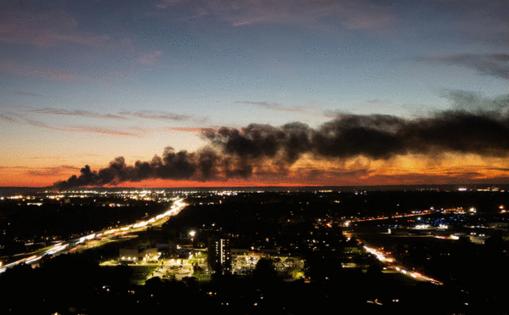NTSB preliminary report outlines key moments before UPS crash in Kentucky
Published in News & Features
The National Transportation Safety Board detailed in a preliminary report Thursday how the UPS cargo plane that crashed in Louisville, Kentucky, earlier this month didn’t get higher than about 30 feet above the ground, based on data from a flight data recorder.
The Nov. 4 crash near UPS’ cargo hub at Louisville Muhammad Ali International Airport killed the three pilots on board and 11 people on the ground. An additional 23 people on the ground were injured.
The preliminary report offers the most detailed description yet of the incident, but NTSB investigations can typically take up to two years to complete.
The MD-11 plane’s left landing gear hit the roof of a UPS warehouse on the edge of the airport, the report said.
Then, the plane hit a storage yard and two more buildings, including a petroleum recycling facility that was mostly destroyed by fire.
Just as UPS flight 2976 bound for Honolulu was taking off, the left engine came off the wing and caught fire as it went above the plane and hit the ground.
A fire also started on the wing of the plane, which continued to burn until the plane crashed.
In a statement after the NTSB issued its report Thursday, Sandy Springs-based UPS said: “We continue to grieve for the lives lost in the tragic accident involving Flight 2976.”
“We appreciate the National Transportation Safety Board’s prompt release of preliminary findings and will fully support the investigation through its conclusion,” the company added.
UPS grounded its MD-11 fleet Nov. 7 as a precaution and on the recommendation of Boeing, which acquired MD-11 maker McDonnell Douglas in 1997, the plane’s manufacturer.
After UPS and FedEx grounded their MD-11s, the Federal Aviation Administration prohibited further flight of MD-11s — as well as DC-10s, which have a similar design — until they could be inspected with corrective actions taken.
The MD-11 has three engines — one on each wing and one at the base of the tail — and this particular aircraft was equipped with GE CF6 engines.
A witness in the air traffic control tower saw that although the takeoff speed appeared normal, the plane did not climb as high as it should have, the report said. The plane stopped climbing and began to descend, then rolled slightly to the left, according to another witness cited in the report.
Parts of the plane, including the left engine and the pylon that attached it to the wing, as well as parts of engine fan blades and other pieces of the left engine, were found on and next to the runway, the report said. Fractured lugs from a mount for the left pylon were found next to the runway.
The NTSB’s report said an examination of the lug fractures found “evidence of fatigue cracks in addition to areas of overstress failure.”
The right engine remained attached to the wing, but some mounts had come off the wing pylon and were found 87 feet away from the engine.
UPS’ maintenance program requires a general visual inspection and detailed visual inspection of the left pylon mount in question every six years, and the last inspections were done on Oct. 28, 2021 — just over four years ago. A special detailed inspection of the lugs would have been due at 29,200 takeoff and landing cycles, and the airplane had 21,043 cycles, the report said.
The NTSB report also detailed the pilots’ experience. The first officer, who was the pilot flying, had about 9,200 hours of flight experience, including about 994 hours on the MD-11, according to the NTSB report.
The captain had about 8,613 total hours of flight experience, including 4,918 in the MD-11. The relief pilot had about 15,250 hours of flight experience, including about 8,775 in the MD-11.
The NTSB cited as a similar event a 1979 crash of an American Airlines flight on a DC-10. That plane, American flight 191, took off from Chicago O’Hare International Airport and crashed after takeoff into an open field, scattering wreckage into an adjacent trailer park. The plane’s left engine came off and fell on the runway, and the plane climbed to about 325 feet and then began to roll to the left.
The crash killed 271 people on the plane and two people on the ground.
The DC-10 and the MD-11 are no longer used for commercial passenger flights.
©2025 The Atlanta Journal-Constitution. Visit at ajc.com. Distributed by Tribune Content Agency, LLC.







Comments